Satellite Radio - Kenwood KTC-H2A1 Tuner
|
|
|||||||||||||||||||||||||||
|
|||||||||||||||||||||||||||
Kenwood Here2Anywhere SIRIUS Tuner |
Kenwood KTC-H2A1
SIRIUS Satellite Radio
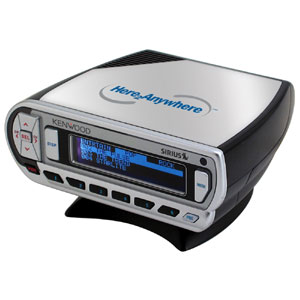
With
Kenwood's new KTC-H2A1 Here2Anywhere portable SIRIUS Tuner,
you can listen to SIRIUS Satellite's 100 streams of digital
entertainment anywhere.
The Kenwood Here2Anywhere
receiver is on the go, just like you. With the optional Home
and Car installation kits you can tune in virtually anywhere.
Imagine the possibilities, you could tune in while in your
car, boat, home, or office thanks to the Here2Anywhere's small
design
The Kenwood Here2Anywhere radio tuner is an excellent solution for the SIRIUS Satellite Radio user who wants to enjoy the service both in the car and the home.
Just slide
Kenwood Tuner into the docking cradle of the optional car and
home installation kits (KPA-H2C and KPA-H2H) and enjoy 60 streams of
commercial-free music and 40 streams of sports, news and
entertainment through your car and home stereo systems. Small enough
to fit into your pocket, just pop Here2Anywhere out of its cradle
and take it with you.
This tuner is lightweight and small. It is easily transported
back-and-forth between locations. Handy docking kits - one for the
car, one for the home - make the interchangeability easy and fast.
The unit itself is slick-looking and provides all the standard
features you would expect from a typical tuner plus, some you would
not. You can program up to 24 presets with your favorite streams or
select any SIRIUS stream directly. The title/artist memory and
recall feature allows the user to remember or look up a favorite
song heard up to the last 36. The Dot Matrix LCD display is easy to
read both during the day and at night. At $99.95, this tuner rocks!
Don't let Here2Anywhere's
size fool you. It's packed with features like a 4-line dot matrix
display with large, easy-to-see characters that scroll complete song
title and artist information, multiple search and display modes, and
24 presets that make finding your favorite stream a snap. It even
has a stream lock feature that lets you skip channels you don't want
to hear (or don't want your kids to hear.) It also has the ability
to save the title and artist of the currently-playing song (up to
24) for recall later, which is perfect for when you hear that great
new song for the first time.
SIRIUS is all about the
music. Their 60 commercial-free original music streams have been
crafted by music lovers to deliver a huge variety of the songs you
want with depth and insight, but without advertising, censorship, or
corporate agendas... and when you want the latest scores or stock
reports, SIRIUS also has 40 world-class news, sports, and
entertainment streams that will keep you on top of your game, 24/7.
KTC-H2A1 - Sirius Satellite Receiver |
Key Features
* Output Level: Adjustable
* Parental Control: Stream Lock
* Requires Optional Car and/or Home Docking Kits
* Signal Quality Screen for Antenna Aiming
* 3 High-Altitude Geo-Synchronous Orbiting Satellites Minimize
Service
Interruptions and Multipath Interference
* Coast-to-Coast Coverage
* Superior Sound Quality
Tuner Features
* Brightness Control: 3-Level
* Multiple Display Modes: Normal, Large Font
* Quick-Release Mechanism
* Search Modes: Stream, Category, Artist, Song, Preset
* Song Title and Artist Memory/Recall: up to 24
* Stream Presets: 24
* LCD Display: 4-Line Scrolling 160 x 32 Dot Matrix
* Remote Control: Full-Function 10-Key
- INCLUDED ACCESSORIES
- Remote Control: Full-Function 10-Key
OPTIONAL ACCESSORIES - KCA-20FM FM Modulator
- KPA-H2C Car Docking Kit
- KPA-H2H Home Docking Kit
| Kenwood Sirius Radio KTC-H2A1 Car Docking Kit
with Wireless FM Modulator MSRP: $99.95
|
|
![[ Kenwood Sirius Radio KTC-H2A1 ]](images/sirius-satellite-radio/kpah2h.jpg) |
Product Code: kenwood-kpa-h2h Price: Check Latest Kenwood Sirius Radio KTC-H2A1 Home Docking Kit MSRP: $99.95 The KPA-H2H Here2Anywhere Home Docking Kit has everything you need to listen to your KTC-H2A1 Here2Anywhere portable SIRIUS tuner through your home stereo system. You get the docking cradle and adjustable base, AC power adapter, audio cable, and a weatherproof indoor/outdoor antenna that's easy to mount. A snap to install, the KPA-H2H and the KTC-H2A1 Here2Anywhere portable SIRIUS tuner are your ticket to enjoying SIRIUS Satellite's 100 streams of digital entertainment right in the comfort of home or office.
Kenwood Sirius Radio KTC-H2A1 Home Docking Kit |
You've probably heard of satellite radio, and you may know that there are two providers of the subscription services, Sirius and XM. While there are lots of products for the car, the home is only this year getting its due. Kenwood's Here2Anywhere receiver for Sirius is ambidextrous: you buy separate fittings to use it in the car or at home. I tried both.
Start-up was easy. Once you've snapped the basic components together and run the antenna outside or fastened it to the roof of the car, you call customer service or go online to activate your account. Suddenly you've got 100 channels of static-free radio.
Picking a channel takes longer than scanning FM, but the reward is sweeter. After jumping around the cleverly named stations, from Symphony Hall to Folk Town, I landed on The Bridge, dedicated to the quarter century of easy rock from Cat Stevens to Sarah McLachlan. It's like taking a personality quiz: no other station gave me such a consistent reason not to touch that dial.
Still, touching the dial isn't so bad. Scrolling up or down, you instantly see what song is playing; before you even hear music, you know whether to keep going or stick around. Higher up the list, you reach the Sirius Entertainment Streams, stations broadcast by partners including CNN, BBC, Bloomberg and Fox, plus ESPN, E! and Disney.
Moving from home to car was simple with the Here2Anywhere. You just snap the receiver into the car cradle (sold separately), which includes cigarette-lighter power jack and a magnetic antenna that clings to the roof without damaging it. I used the cassette adapter; you can also use your car stereo's auxiliary input.
In the car, I noticed a sound quality issue. In MP3 jargon, Sirius broadcasts at a variable bit rate up to 128Kbps, so in a system with nice speakers, you're bound to notice the compression. A strong standard radio signal might sound better, at least momentarily. On the flip side, although satellite radio might blink in and out in heavily wooded areas, it is normally consistent: the signal never varies in volume or goes fuzzy.
The sleek Kenwood KTC-H2A1 brings Sirius satellite radio to your
home and connects directly to your stereo system--whether that be a
receiver, a shelf system, or a pair of powered speakers. The KTC-H2A1
features a 4-line blue-on-black dot matrix display with
dimming control, up to 80 station presets, and a 24-song memory.
Note that the KTC-H2A1 requires a Sirius home antenna in order to
receive satellite radio signals.
You can store a total of 80 presets in 4 banks (20 presets each),
as well as store song title and artist name for 24 songs for easy
recall later. Using the Song Seek feature, an alert appears on the KTC-H2A1
display when a saved song is playing on another station
(also called a stream). The display shows a read-out of channel
number, name, category, preset bank and number, artist, and song
title. You can control the KTC-H2A1
via the supplied remote control,
or use the two jog dials on the front of the device to scroll
through either individual channels or Sirius radio categories (such
as rock, jazz, sports, or news). The KTC-H2A1 offers both RCA
composite A/V and optical digital audio output.
Sirius satellite radio is a subscription service that provides up
to 100 channels of programming, from digital-quality music to news,
talk, and sports. It is available only in the lower 48 states--not
available in Alaska, Hawaii, or U.S. territories.
|
Kenwood - Sirius Satellite Tuner |
Satellite Sirius Radio - Kenwood KTC-H2A1 |
Product Description Kenwood SIRIUS Tuner |
The Kenwood KTC-H2A1
brings Sirius Satellite
Radio into your home. Not to be confused with portable Sirius
Satellite tuners this is a true Home Audio Component. With a 4
Line display you can see the Artist name of the current song
playing, as well as Song Title, Radio Station and Category. The KTC-H2A1
has 4 preset nameable banks, that hold up to 20 stations
each, meaning it can be programmed to store 80 presets in memory.
With features like Song Seek, a song can be entered into the
memory and the next time the song is playing on any Sirius channel
the unit will inform you it is playing and allow you to switch to
the channel so you can enjoy the song. Sirius Satellite services
entertain you with 60 commercial free music stations and 40 News
and Entertainment stations. The coverage is Coast to Coast and
fully digital. Service costs $12.95 a month.
Do you need to get satellite radio in
the house as well as in the car? The current crop of
"plug-and-play" tuners (those little ones you can move
from house to car to boombox) are definitely convenient, but you've
been looking for something with a more "permanent" look
for your home system. The KTC-H2A1 is
a component-style, full-sized SIRIUS satellite radio tuner with a
big blue LCD display and some pretty futuristic styling. I decided
to bring it home and put it through its paces.
First impressions
When the KTC-H2A1 arrived at my desk, I couldn't wait to check it
out. I pulled it out of the box and plugged it in, just to get a
feel for how it looked. The tuner offers a bank of numerical buttons to the left of the
LCD, for entering stream (channel) numbers directly. To the right
of the LCD, you get buttons for saving songs to memory, scrolling
through preset banks, adjusting the display, and selecting
"direct" or "preset" stream access. Two rotary
knobs located on the top of the unit (check out the photo
above) let you scroll through channels and categories. I loved
the tactile "click click click" of the rotary knobs, and
the LCD was bright enough to read easily, even right below a
window with sunshine streaming in.
On the back panel of the tuner, along with the
standard RCA analog outputs and optical digital output, there's an
RS-232 (serial) terminal. The serial port is not for hooking the tuner up to
a computer, but instead allows it to interface
with "compatible third-party control systems." Kenwood
recommends that it only be used by professional system installers.
Making the connections
When it comes to hooking up the KTC-H2A1, we have got one word for
you: easy. The toughest part about the installation was finding a
spot for the tuner on my overcrowded A/V rack. The installation was hardly more involved
than hooking up a CD player. You just plugged in the antenna (not
included, by the way), connected a set of analog RCA cables from
the tuner's output to an available input on stereo receiver or
amplifier, and plugged in the power. After a few anxious moments of
"Acquiring Signal" on the LCD screen, you will be ready to
roll with the dog! The KTC-H2A1 making a really cool
stand-alone bedroom or office system, too — you'd just need to
connect the analog outputs directly to a pair of powered speakers.
|
Kenwood - Sirius Satellite Tuner |
Sirius Kenwood KTC-H2A1l - Sirius Tuner back |
Ah, summer vacation. The traditional
American family getaway. As usual, my family prepared to make our
way to the outer banks of North Carolina (OBX to the locals) for a
week at the beach. It's great to be at the beach, but the five hour
drive with my wife, son, nephew and dog is not the highlight of the
trip. What better way to improve the ride than to test the new
Kenwood KTC-H2A1 "Here2Anywhere" SIRIUS satellite radio
tuner!
I don't need any convincing of the utility and pleasure of satellite
radio — I've had an XM tuner in my truck for the last year, and
can truly say that it's revolutionized how and what I listen to on
my mobile audio system. When the opportunity came to test Kenwood's
new SIRIUS tuner, I jumped at it — it looked like a great way to
give it a real world test.
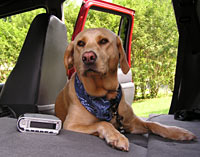 Faithful companion Ginger (right), ready to test the tuner (left).
|
The gear
Kenwood's Here2Anywhere SIRIUS satellite radio tuner is designed for
easy use in the car and home, filling a major hole in the SIRIUS
hardware lineup. Until its appearance, there had been no
SIRIUS-compatible equipment available for home use. The
Here2Anywhere system consists of a tuner that can be used with
either a car or home kit (both sold separately). The tuner easily
slides in and out of the docking station that stays in your car or
home, connected to power, audio and antenna
The installation
The Here2Anywhere car kit comes with all the basics for
installation: The docking station for the tuner, power cable with
cigarette lighter adapter, magnetic mount antenna with cable,
cassette adapter, and RCA stereo patch cables (for use if you have a
receiver with stereo auxiliary inputs). Since I was hooking this up
to the stock system in our 2001 Explorer, I used the cassette
adapter. If you don't have a cassette player or auxiliary inputs
available, you'll need to purchase an RF modulator to input the
signal to your receiver.
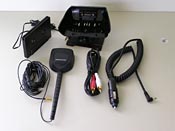 The Here2Anywhere car kit comes with virtually everything needed for easy hook-up! 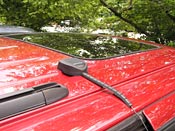 The magnetic antenna sticks to the job on the roof of the Explorer. The cable is quite thin, durable, and easy to route. 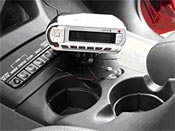 The Here2Anywhere tuner mounted in the cradle and secured to the center console. The tabs on the metal plate at the bottom bend to conform to where you mount it. |
Installation was easy. Since I was only going to have the equipment
for a week or so, I wasn't concerned about a long-term installation
solution, just getting the tuner up and running with a minimum of
fuss. The magnetic mount antenna went on the roof. I then snaked the
cable in along the front door's weather stripping and from there,
along the carpet trim panels to the Explorer's center console, where
I would mount the tuner's docking station.
The docking station comes with an attached metal base plate that can
be easily bent to conform to the location you're mounting the tuner.
Since this a "universal" mount, there's no
"right" or "wrong" place to put the unit —
just pick the spot that works best for you. For this installation I
simply mounted the docking station to a small piece of carpeted wood
wedged into a storage slot on the center console. It was an easy job
to angle the tuner towards the driver's seat using the docking
station's pivoting ball and socket. Although the docking station's
pivot mount didn't have sufficient travel to allow me to tilt it
quite as high as I would have liked (for better visibility), it was
the best location I could think of. The size and depth of the unit
isn't particularly conducive to easily finding a good mounting
location — as you can see in the picture it does take up a fair
bit of room.
Connections were extremely easy. One cable plugs in for the antenna,
another for the cigarette lighter power cable, and another for the
cassette adapter. That's all there is to it!
A quick call to SIRIUS, using the phone number provided in the
manual, and the tuner was activated and receiving all of its
channels, or "channels" as SIRIUS refers to them.
Using the Here2Anywhere tuner
Right from the start, the Here2Anywhere tuner was easy to use and enjoy. The face is clean, with a minimum of buttons to complicate operation. The four-way toggle on the left side allows you to scroll easily through the channels and make your selection by pushing the SEL button located in the middle. A particularly well-thought out feature is the ability to scroll through channels without changing the channel to which you are currently listening to. As you can see in the photo, navigation is accomplished by moving up or down within a category, such as "rock" or "country," and scrolling side to side to change categories. It didn't require any trips to the manual to figure this out. As a matter of fact, I rarely referred to the manual while installing or using the Here2Anywhere tuner.
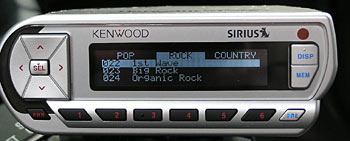 The easy-to-navigate screen and controls of the tuner. Selecting channels was easy and intuitive. |
Once you've selected your channel, the display changes to a well-designed information screen. The artist and song information scrolls constantly, so checking out what you're listening to is easy. Kenwood deserves high marks for a simple, easy-to-use design. I would have liked the display to be a bit brighter — on sunny days it was sometimes difficult to read, particularly with my sunglasses on.
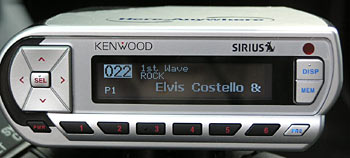 The display scrolls to present song and artist information when you've selected a channel. Plenty of information in an easy-to-read format. |
The visibility issue was aggravated by the relatively large size of the tuner. For lack of any place better to put it, I had to mount it well below eye level, a real problem if you want to change stations while in heavy traffic. Granted, there are plenty of presets on the tuner, and familiarity with the SIRIUS music channels and use of the included remote would make that less of a problem over time. However, the size of the tuner limits your mounting locations.
You can't beat the variety of programming available on satellite radio, and we took full advantage of it. During the course of our vacation we enjoyed many of the SIRIUS channels, particularly "The Trend" (new and classic rock album tracks), "Pure Jazz," "Planet Jazz" (primarily jazz fusion), "Totally '70s" and "Big '80s" (OK, I'm getting old), "First Wave" (classic alternative rock), and "Radio Disney" (well, my nine year old son enjoyed it). There's plenty of variety, and something for just about anybody.
(Check out "Critical Listening" by Lindsay Planer, for more on satellite radio programming)
To sum up, the Here2Anywhere tuner let us tailor our music to suit our interests and mood. It was easy to install and use — all in all, a nice addition to have along for the ride.
Despite the excellent variety of programming, two issues surprised me. SIRIUS promotes its 60 channels of "commercial-free music." While we didn't hear any commercials when listening to SIRIUS' originally produced music channels, many of the talk, news, and variety programs that don't originate with SIRIUS have commercials. If you want to listen to the news, or if you have a nine-year old "tweenager" in the car who likes listening to stations like Radio Disney, you'll spend plenty of time listening to commercials.
As someone accustomed to passing my morning and afternoon commute listening to the news on National Public Radio, having two channels of NPR on SIRIUS sounded like a great feature. I was somewhat disappointed not to be able to listen to their flagship programs Morning Edition or All Things Considered — they weren't there! NPR reserves these programs for their local over-the-air member stations, so you'll have to turn off the SIRIUS tuner and turn on the FM if you want to listen to those programs.
Reception of the satellite signal was generally very good, though it did seem somewhat more prone to signal drop out than I am accustomed to with my XM tuner. Probably because of satellite positioning at different times of the day, I found that the signal sometimes would fade out when going under overpasses, and sometimes would not, depending on the time of day. On the whole, this was a very minor problem.
How about the sound? Well, I didn't expect anything amazing from the stock sound system in our Explorer or the lesser sound quality of the cassette adapter. (Even if you have a cassette slot, an RF modulator will give you a cleaner installation and a little better sound quality, if you don't mind some extra installation work.) I did notice a clear improvement over FM — reception was interference- and static-free and the imaging and bass response were improved. As is the case with all types of compressed data (MP3 and WMA files included), I could hear a clear difference between the clarity and imaging of a CD versus what I experienced with the SIRIUS channel.
The future
The Here2Anywhere car kit did a good job as a universal tuner for our car. Throw in the capability of adding a home kit, and you've got an even more attractive option. It's ideal for the consumer who would like to subscribe to SIRIUS and enjoy it both in the home and car. For me, it delivered trouble-free service in an easy-to-use package.
There's no doubt in my mind that satellite radio is here to stay. As familiarity with the services grow, and as more options (including factory-installed systems) become available, subscriber numbers will increase. More and more satellite radio subscribers will want to have satellite radio in their home without paying for an extra receiver. If you've decided you're ready to take the plunge into satellite radio, have decided on SIRIUS as your provider of choice, and want the flexibility of having SIRIUS in your home and car, the Here2Anywhere is a good choice.
Kenwood’s “Here2Anywhere” Portable Sirius Kit
By John Figliozzi
Sirius Satellite Radio is one of two active satellite digital radio subscription services (licensed by the FCC as Digital Audio Radio Services) available in the continental U.S. XM is the other and was extensively reviewed in March’s MT, along with Delphi’s SKYFi system. (Neither service has been licensed in Canada by the CRTC, so service is not “officially” available there though reception appears fine.)
The Sirius System
XM uses geostationary satellites arrayed along the equator, 22,300 miles in space. Sirius takes a different approach. Its three Space Systems/Loral satellites form a geosynchronous inclined elliptical constellation staggered in orbits separated by eight hours (see Figure 1). This ensures that each satellite spends about 16 hours a day over the continental U.S, with at least one satellite over the country at all times. The satellites are 29,200 miles in space at apogee over Manitoba and 14,900 miles up at their low point. [Those interested in further technical information about the Sirius satellites may consult http://www.ssloral.com/html/products/prodserv.html#1300.]
Programs are beamed from the uplink site (Sirius studios in New York City - see Figure 2) to the satellites, which in turn transmit the signal to the ground, where a Sirius radio receiver decodes its 100+ channels.
This is a “line of sight” reception path. So, like XM, Sirius uses ground repeaters in areas where the signal from the satellite is likely to be interrupted by obstructions. However, Sirius can employ far fewer repeaters because its system places a satellite almost directly overhead at an angle of elevation always greater than 60 degrees, as opposed to a 30 degree maximum for XM’s equatorial system. Sirius’ signal, therefore, is far less likely to be obstructed.
There are two parts to the Sirius receiver: the antenna module and the tuner module.
The antenna receives the signal, amplifies it, filters out interference and passes it on to the tuner. The tuner module is an Agere chipset consisting of eight chips, which converts the signal from 2.3 GHz to a lower intermediate frequency or is adapted to allow conventional car radios to receive and play the signal. [A more extensive description of the technology and how it works can be found at http://www.elecdesign.com/Articles/Index.cfm?ArticleID=5603.]
The Sirius Service
Sirius offers 104 program “streams” clustered into twelve broad “categories.” They are: Pop (9 streams), Rock (13), Country (5), Hip-Hop (5), R&B (4), Dance (6), Jazz/Standards (6), Classical (3), Variety (9), News (16), Sports (8) and Entertainment (20).
The 60 music streams, all programmed by and originating from Sirius in New York City, carry no advertising. Just about every music angle is covered, including today’s top hits and pop music classified by decades, easy listening and adult contemporary; classic, alternative, modern, indie and Christian rock; blues to bluegrass; rap, soul, electronica, disco; swing, standards and show music; country to classical; folk to gospel; reggae to world music; latin to new age. Stream 100 offers daily live in-studio performances at 6 p.m.
The 44 non-music streams include news, talk and information from CNBC, Bloomberg, ABC, CNN, NPR, PRI and Fox; international perspectives from the BBC and the World Radio Network (see Programming Spotlight in this issue); regional weather services; streams for kids, truckers, the gay and lesbian community; a comedy channel and classic radio shows. Prominent brands including C-SPAN, Disney, WSM, E!, A&E, Discovery, ESPN, Speed Channel, Sports By-Line and Court TV program their own streams. Sirius also has concluded contracts with the NBA and the NHL providing live play-by-play coverage of up to 40 games a week from each league.
There are five Spanish language channels, including BBC Mundo and Radio Deportivo and two channels offering Mexican and Latin music.
The variety is breathtaking, to say the least.
Kenwood’s Here2Anywhere Kit
The Kenwood “Here2Anywhere” KTC-H2A1 Tuner, KPA-H2C Car Docking Kit and KPA-H2H Home Docking Kit combine to form a shuttle system that allows the listener to transport the tuner between the car and the home and have access to the service in both locations, under a single subscription. (It can also be used with a marine audio system or a personal computer.)
The plug and play tuner is somewhat oddly shaped (like a pita pocket), but not unappealing. Its front face (see Figure 3) is dominated by a display, which shows the stream (number and name), category, artist, song and set-up information. To the right are buttons marked “DISP” (for display) and “MEM” (for memory). To the left are similar buttons arranged in a square each with a vector signifying up, down, left and right. Another button in the center of these four is marked “SEL” (for select). Beneath all this are six pre-set number buttons flanked by a “PWR” (power) button and a “PRE” (preset) button.
A remote is included with the tuner and includes all these functions plus a button market “DIRECT” that allows the user to enter a stream number and move “directly” to that program.
The up and down vectors select streams sequentially. The right and left vectors select categories sequentially, serving as a means of moving more quickly across the spectrum. There are many sophisticated functions, too numerous to describe fully here. However, the listener can select music (or other programming) by stream, artist and song (or program), set up to 24 presets (especially handy – if not essential – for use in the car), save and recall information for up to 24 songs for later reference. The display can be set for brightness, for normal and large fonts, or to show information by stream or by category.
The rear of the tuner has a recessed plug and the underside of the tuner has a push button release for removing the tuner from a docking unit.
Home and Car Versatility
The tuner must be mated to a docking unit. Two units are offered: one for home and one for the car. The car unit works with your existing OEM receiver. Each includes a cradle (see Figure 4) into which the tuner is plugged, an adjustable base, a weatherproof antenna module (with magnetic base on the car unit) and an audio cable. The car unit also includes a carry bag, a cassette adapter and a cigarette lighter power adapter. The home unit includes an AC power adapter.
The rear of each cradle has connections for the antenna, power and audio cables. With the car unit, there’s an option to use the OEM receiver’s auxiliary input (if available) or the cassette adapter. With the home unit, the audio cable connects to an auxiliary input on the home stereo system.
In car installations, Sirius and Kenwood recommend that the antenna (see Figure 5) be located on the roof (or the trunk lid on convertibles) on a metal surface at least 12”x12”, and at least 6 inches from a window. With home installations, the antenna can be placed outdoors or near a window facing roughly the north central portion of the country. The tuner includes an antenna signal strength display option that assists in proper placement.
How Well Does It Work?
This is line of sight reception, so anytime the antenna loses contact with the satellite for any significant period, there will be silence. Having said that, silent running is infrequent and fleeting -- occurring only in tunnels and unusually long underpasses, where high structures obstruct access to the satellites and under very heavy tree foliage. Cloud cover, fog and rain have no effect on reception.
Antenna placement also appears to be far more forgiving than the impression given by printed instructions. In the car, I experimented with the antenna on the front dashboard (not recommended for safety reasons) and on the inside deck under the rear window. In my wood frame house, the antenna is in the middle of the room nowhere near a window. In both cases, reception has been fine. However, because the satellites are in motion, reception strength at a given location varies somewhat from time to time. The home antenna sometimes required slight repositioning within the room.
The acoustic experience is pleasing, though it appears to have slightly less depth than that of a CD to these 50 year old ears (admittedly battered by nearly 40 years of shortwave listening and DXing). However, satisfaction with the audio also depends a great deal on the caliber of the car or home stereo system to which it is connected.
The Costs
MSRP for the tuner unit is $99; for the docking units -- $69 each. However, Sirius and Kenwood offer a $50 rebate for those purchasing the tuner and both docking units -- making the final equipment cost for both home and car access $149.
Activation charge is $15 by phone; only $5 via online. The subscription charge is $12.95 per month, with up to three additional subscriptions $6.99 a month each. A one year pre-payment yields 1 month free; two years, three months free. There are other cost-saving options as well.
Kenwood, Audiovox, Clarion, Blix and Panasonic offer several other equipment options. Vendors include Circuit City, Sears, Best Buy, Good Guys, Tweeter, Ultimate Electronics, Crutchfield and other retailers and specialized consumer electronics distributors. Sirius also has arrangements with car makers placing Sirius-ready OEM receivers in many new cars. [http://www.siriusradio.com has all the details.]
Recommendations
There is no doubt that satellite radio offers a listening experience far superior to that of AM and FM radio. In essence, XM and Sirius offer services of similar quality; therefore, personal preferences will guide consumer choice. For me, the added availability of three U.S. public radio streams and the World Radio Network (with access to over 25 international broadcasters), along with the non-commercial nature of the music streams and the availability of free on-line access anywhere, brought me to Sirius despite its slightly higher monthly subscription cost. Your mileage, as they say, may vary.
The plug and play system is the least expensive and most versatile option. Access at home and on the road requires only one subscription and installation does not require costly professional help. Kenwood’s equipment appears to be well made and durable, although the tuner does generate considerable heat (which is effectively dissipated through an aluminum heatsink).
In sum, you can’t go wrong in my estimation. The car is an ideal radio listening environment. The Kenwood Here2Anywhere Sirius Satellite Radio plug and play system is affordably priced and presents another option for quality radio listening, not only in the car but also in the home -- for the price of a lunch per month. For international radio afficionados, Sirius offers – through the BBC and the World Radio Network -- many of the benefits of shortwave radio with better signal dependability and high quality audio.
So, what are you waiting for?
For
our review purposes, the system we evaluated was the Kenwood
KTC-H2A1 Here2Anywhere unit (which retails for $99.95). It includes
what's called a "home docking station", which is basically
just a small stand that accepts the unit as a snap-in. With the
docking station's small footprint, the unit fits almost anywhere you
have a bit of space - a shelf, a corner of your desk, etc. It's
unobtrusive and blends in well with whatever other hardware it might
be sharing space with. It includes audio cables that fit your
existing stereo receiver - the sound outputs through the receiver's
attached speakers. There's also a small satellite antenna included,
which receives the digital transmission and relays it to the unit.
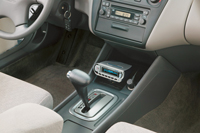
Here2Anywhere
installed in car
Sirius operates a trio of broadcast satellites, circling the Earth in a high geostationary orbit over North America. This means that reception is generally excellent anywhere in the U.S., provided you can place the antenna near a North, East or West facing window (the best direction depends on the geographic region you live in). Note that you can also mount the antenna outside or on your roof (it's weather-proof). Living as we do in Southern California, the best reception direction for us is North/Northeast. Bill's office has an East-facing window, but Matt's office window faces West, which meant that his reception was a little spotty initially. Purchasing another 50 feet of extension let him roof-mount his antenna, which alleviated the problem. Just FYI, for those of you who live North of the border, Sirius is reportedly working to bring the service to Canada as well.
Once you have your unit installed, you need to call Sirius' toll free number to activate it (there's a $15 activation charge if you do this by phone - you pay only $5 if you activate your unit online). Each receiver has its own ID/ESN code number. Once you've arranged billing and selected a service plan, you simply give the operator your unit's code number and they send out an activation signal (via satellite) to turn on your receiver (it usually takes between 30 seconds and 5 minutes). Voila... you're up and running.
The Kenwood Here2Anywhere unit includes a remote that lets you scan the streams easily (you can also do so with buttons on its face). You have the ability to scan other streams visually, without interrupting the one that's currently playing. Better still, you can see not only the names and numbers of the other streams, but also the specific artist and song that's currently playing on each. The Here2Anywhere can remember 24 artist/song title sets in its memory (for example, if you hear a song that you like and wish to remember later), and you can also program 24 stream presets for quick access.
When searching for a stream that may interest you, you can choose from a menu that describes the stream's format by use of certain naming conventions (for example: Alt Nation, First Wave, The Pulse, Jam Central, and so on). You can also change streams on the fly by selecting them with your remote (by moving to the next or last in the list, or by jumping right to the stream you want by entering its specific number).
If you're on the go, home installation isn't the only option with the Kenwood Here2Anywhere. Just unsnap the unit from your home docking station, tuck it into its carrying pouch, and take it on the road with you in your car. The unit also snaps into a special auto docking station that's available (it can be mounted to your dash, or elsewhere in your vehicle). A small antenna is mounted on your roof (it's held securely in place magnetically), and you just run the wire out of the way (under the carpet for example) into the back of your unit. In theory, you could also mount the antenna on your dash or in a window space - anywhere you get direct line-of-site to the sky. Installation is fairly easy to do yourself, or you can get it done by a qualified professional installer. A standard cassette adaptor can then be used to run the sound through your car's existing tape player so you can hear the sound through your existing speakers.
We've
put the auto option through its paces, and we can report that it
works very well. In fact, when we drove to CES in January, we took
the Here2Anywhere with us. Rather than bothering to install the
unit, we simply set the antenna in the back window. Reception was
near perfect for the entire 4-hour trip to Las Vegas, even when
passing through the mountains or the middle of Death Valley. In
fact, the only time reception really wavers in your car is when you
pass through a tunnel or under the occasional freeway overpass,
which is to be expected given the satellite's line-of-site
transmission format. But once you're back out in the open again, the
signal is immediately reacquired (we never lost the signal for more
than a second or two at a time during the CES trip, and then on only
a handful of occasions).
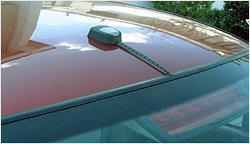 |
|
Roof-mounted
antenna
|
 |
thumbnail to download Kenwood KTC-H2A1 Here2Anywhere Sirius Satellite Radio User's Manual (PDF 3,358K) |
Click
here if you need to download free Acrobat Reader® software |

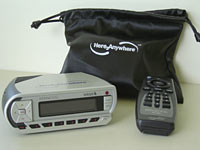 The Here2Anywhere tuner, complete with carrying pouch and
remote
The Here2Anywhere tuner, complete with carrying pouch and
remote